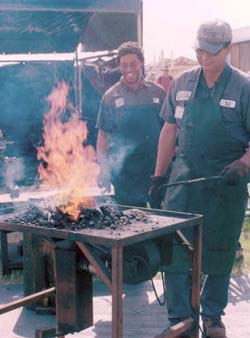
Table of Contents
Introduction: The New Orleans Building Arts Project
Builder's Voices
Brick Masonry
Carpentry
Ironworking and Blacksmithing
Tile Masonry and Painting
Plastering
Shoring, Plant & Maintenance Engineering
Wood Crafting
How the Seventh Ward Was Built
Labor Day

Darryl Reeves (Blacksmith)
My mother's from outside of Donaldsonville, a place called St. Emma Plantation. My grandfather [Clifton Joseph] and my grandmother [Olivia] on my mother's side had 13 children. At the time, doing farm work, they had a lot of kids because they helped with the farm. My grandfather worked for the plantation. My grandmother was at home, she kept the home. By having a farm, at one time, nobody could survive without blacksmithing—at least up till the last 50 years. Before that you had to have some form of blacksmith shop on your farm, and that's just the way it was. The largest blacksmith shop in the [19]20s had something like 2200 employees. And after that, blacksmith shops pretty much faded away. . . . They had more than four in the Quarter that I know of. Blacksmith shops, especially with New Orleans being a major shipping port, had a lot, because a lot of the hardware for blacksmiths came in through the port from Spain and France and they pretty much spread a lot of the stuff. People bought it from New Orleans.

The forge is a mixture of different old parts. I have a fire pot; the fire pot's over one hundred years old. I have a hand blower that's on it that's over a hundred years old, and I made a table with a retractable hood over it to use as I need in my shop. Other than making a fire pot myself from scratch, it's just not worth buying any new one. They have companies where you can still buy some of this stuff, but I feel a connection with old parts. A lot of my work is restoration work and when I'm doing a restored job, I make it a point to use every bit of the original parts to the piece as possible. So working on something old give me a personal connection to it, I guess.
Say that fence at the Cabildo—a lot of that was done by what they call "sweat and metal together." That's basically having one bar that has a hole in it that's 1/32 of an inch smaller than the bar that you want to run through it, and the only way you're going to get these two pieces of metal together is by heating that flat bar to get that hole that's a 1/32 smaller to be either the same size as the bar you want to run through it, or a little bigger. So you heat it up. You make the hole bigger. Then after you put the bar in the middle of this hole, when that flat bar cools off, it grabs the bar. And that's one of the methods we use of grabbing the bar.
When you're using a tool on something, especially like a die, it has to be a hardened steel, because it's constantly getting hot and cold, and if it can't deal with these environments, you'll be making tools every week. So we try to find [good materials]. I just happen to be partial to Chevrolet car and truck springs, because I find that they make the best tools. There's nothing else I can say about it. It's just the way I feel. We make all types of jigs, any type of clamp, tongs that we use. You gotta remember, we're working on top of a forge that's kicking out a temperature of 2500 to 3500 degrees. If we don't have the tools that can handle these temperatures, you can't do your job. And for me, I like the light tools. I like them not too long, but not too short. And just to go out and buy something like that, you're not going to find it. You have to make it.
The welding shop was taking care of its own, but it wasn't the market that I wanted. I wanted to take metal, heat it up to 2200 degrees and shape it and do what I wanted to do. Do something unique, out of the ordinary. Something that the average person can't do.


